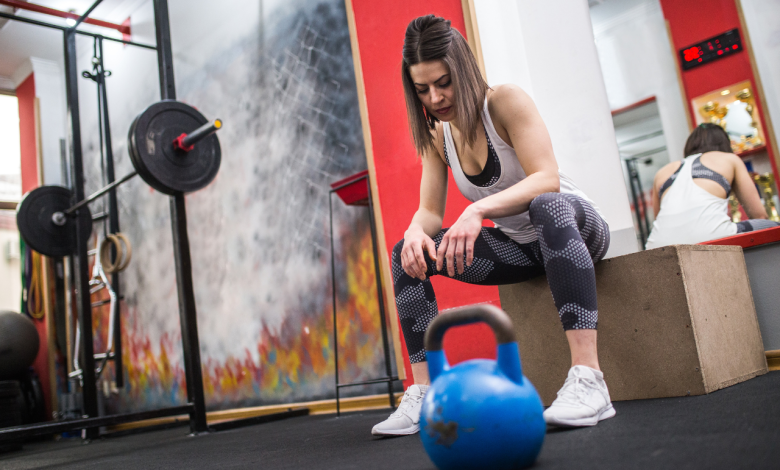
A kettlebell is a reasonably versatile piece of sports gear. The key to using a kettlebell effectively is to perform movements in accordance with protocol, just like when using any other piece of equipment. To do this, read the kettlebell workout plan before beginning the movements.
Training with a kettlebell begins two processes simultaneously, unlike jogging or working out at the gym: fat burning from the high volume of repetitions and muscle building from the weights. Relief, strength, and endurance are the outcomes of everything. Women often select kettlebells that weigh between 8 and 16 kg.
Benefits of kettlebell training for women
Kettlebells are a universal projectile. You can work with them both in the gym and at home, perform workouts for strength and muscle size, or arrange circular cardio sessions for weight loss and endurance.
- Large power effectiveness. This sports toolbox has been acknowledged as one of the best for boosting power;
- The cardiovascular system benefits from kettlebell exercise. Blood pressure and heart rate both fall;
- Noticeable improvement in body composition. Women involved with kettlebells have well-developed organs and muscles;
- Enhancing the hip joints’ strength. Practically the only sports option to strengthen the hip joints is kettlebell training;
- Return of mobility to the back. The development of the extensor ability of the back is the best way to promote training with kettlebells;
- Certain kettlebell movements are distinctive and impossible to do in other sports.
Tabata kettlebell workout for women
Tabata exercises are a terrific approach to attain your aim of losing weight rapidly while also improving your shape. To do the most motions in the smallest amount of time is the goal of tabata training, a form of high-intensity interval training. The framework of tabata training is as follows: 8 cycles of 20 seconds of maximal load followed by 10 seconds of relaxation are possible.
Avoid doing the same workout more than three times in a row by attempting to switch up the set of tabata movements. Even with the same exercises, the weights become less effective as your body adjusts. Change both the set of exercises and their sequencing. An illustration of a tabata exercise using kettlebells for ladies:
First exercise.
Kettlebell swing – 20 seconds, rest – 10 seconds. Exercise technique:
- Put your feet slightly wider than your shoulders and stand up straight.
- Grab the kettlebell with both hands, lean forward slightly and slide the kettlebell between your legs.
- The back should remain straight, without rounding.
- Lift the kettlebell up to your shoulders. The movement starts from the hips, and not from the hands, which provides the power of the push.
- Lower the weight down, bringing it between your legs again, and repeat the exercise.
Second exercise.
Deep squat with a kettlebell – 20 seconds, rest – 10 seconds. Exercise technique:
- Holding the kettlebell with both hands in front of your chest, stand tall.
- Maintain a close elbow position.
- Do a deep squat while maintaining a straight spine and pushing your pelvis back.
- The hip joint should be below the knees at the bottom of the squat.
- Repeat from the original position.
Third exercise.
Kettlebell lunges – 20 seconds, rest – 10 seconds. Exercise technique:
- Stand up straight, hold the kettlebell in a bent arm at shoulder level, elbow close to the body, hand turned palm to the body.
- Lunge forward and at the same time raise your arm with the kettlebell above your head.
- Return to the starting position by lowering the arm with the kettlebell during the lift.
- Repeat with the other leg.
Fourth exercise.
Deadlift with a kettlebell – 20 seconds, rest – 10 seconds. Exercise technique:
- Stand straight, feet shoulder-width apart, hold the kettlebell in both hands.
- Tilt the body, take the pelvis back and lower the weight to the floor.
- When you stoop, maintain a straight back.
- Return to the starting position by tightening your buttocks and abs.
- Repeat the exercise.
Repeat all exercises one more time for a total of 8 exercises for 20 seconds, and 8 times for rest for 10 seconds. As a result, you need 4 minutes for one round. For training to be considered effective, do 4 circles, if you want a better result, do 6-8 circles. Keep in mind that kettlebell exercises should be full-body movements with high intensity for kettlebell tabata workouts to be effective.
Kettlebell circuit training for women
Training is conducted in a cyclic fashion. Perform each exercise one after the other in a sequential manner. It is advised that you complete each exercise 2-4 times for a comprehensive workout. You may time it by the number of repeats or by the timer of your choice.
1. Squats with kettlebell lifting.
Place the kettlebell on the floor. Your feet should be on the sides of the kettlebell while you are standing straight and with your shoulders back. When your thighs are parallel to the floor, squat down and place your right hand on the handle while lowering your left hand along your torso.
Maintaining a straight body and legs, raise the kettlebell to shoulder height. The projectile should now be above your head as you raise your arm straight up. Your left hand ought to be extended. At this time, lower the weight to the floor, then raise it to the beginning position and repeat on the other side.
2. Jump squats.
As you lay there with your hands on the projectile and your arms straight, put your weight on the ground and take in the scene. Instead of bending at your lower back, strengthen the muscles in your core.
Then, with your knees still bent and your hips still parallel to the ground, leap forward while retaining your hands on the support. Raise the kettlebell up in front of you while maintaining a 45° angle with the floor. Repeat from the original location.
3. Twisting lunge.
Take the weight in both hands and bring it to your chest while keeping your elbows bent. Set your feet firmly together and stand straight up. Knees are bowed just a bit. With your right leg bent so that your thigh is parallel to the ground, take a step back with your left leg.
Turn the body to the right and lower the weight to the right iliac bone while utilizing the muscles in the press, back, and legs. After that, carefully retrace your steps back to the beginning, then repeat on the opposite side.
4. Lunge squats.
With your elbows bent, take the weight in both hands and bring it to your chest. With your feet somewhat broader than your shoulders and your socks sticking out to the sides, stand up straight. By bending your knees until your thighs are parallel to the floor, you may lower yourself into a squat.
Straighten your right leg so that your thigh is parallel to the floor before lowering yourself into a lunge. Put your weight on your right foot, turn your torso to the right, and straighten your left leg. The toe of the left leg is supported. Repeat the exercise an equal number of times in each direction, then return to your starting position.






